5 Days Lhasa Highlights & Holy Lake Namtso Tour (Price from $839)
Epitome of Tibet
Where to see the most breathtaking natural scenery of Tibet? There may be many answers, but Namtso Lake has more clout than most.
Namtso Lake, featured with transcendent turquoise blue and shimmer water, as well as lofty altitude, spiritual association, attracts flocks of natural lovers and photographers. This trip is ideal for those with limited time but still want to see Namtso Lake and the major cultural attractions (Potala Palace, Jokhang Temple, Sera Monastery...) in Tibet. You will spend two days visiting Lhasa landmarks and acclimating with the high altitude before an efficient day trip to holy lake Namtso. During this tour, cultural exploration and natural savory will undoubtedly leave you a long-lasting memory of your Tibet experience.
Highlights of this tour:
- Get amazed by the amazing appearance of Potala Palace from different perspectives before walking into the palace to explore the treasurable collections;
- Soothe your soul in an otherworldly mix of flickering butter lamps, wafting incense and murmuring Buddhist pilgrims in Jokhang Temple and Barkhor Street;
- Admire the typical Tibetan buildings and collections of Lhasa most important monasteries with a spectacular Buddhist scripture debating in Sera Monastery;
- Submit to the heavenly turquoise of holy Namtso Lake and its spectacular surroundings – continuous snow-capped peaks, vast prairies, flying prayer flags, etc.
Tour Brief Information
-
Tour price: from
$839
1. This price is based on a group of 2 adult travelers who will take our private tour and share one standard rooms in regular local 4-star hotel in lower seasons.
2. This price is subject to change according to your traveling season, group size, hotel class, change of activities in your itinerary and possible fluctuation of currency exchange rate. If you want a lower price, you can get more people to join you, or use economy class hotels.
3. This price is only valid to March 31, 2025.
4. Reference exchange rate of USD 1= RMB 6.85. The final quotation will be adjusted according to the latest real-time exchange rate.
- Tour code: TD-LNT-05
- Tour type: Private Customizable Tour Package
- Destination: Lhasa / Namtso / Lhasa
- Duration: 5 days and 4 nights
- Departure: Flexible
- Travel Theme:




- Best Time:


- Physical Level

- Tour Pace
- Max Altitude
5,190m
- Itinerary Details
- Included Services & Fees
- Reviews
- Gallery
- Make an Enquiry
Itinerary Details - Day by Day
Day 1 Lhasa Arrival
Lhasa airport/train station pick upWelcome to the roof of the world! You will be picked up by local tour guide at Lhasa airport hall or train station, and then be escorted to check in your hotel in Lhasa city (3,650 m) in a private vehicle. The rest of the day is free for you to explore the local areas and acclimatize yourself to the air, temperature and high altitude of Lhasa.
High Altitude Acclimation Tips: 1) go for some leisure walking to acclimate the high altitude but avoid strenuous activity after arrival; 2) you'd better not have bath, in case of catching a cold; 3) drink more water, and have some fruit; 4) have a good rest...
How to Get to Lhasa: take a domestic flight from other cities like Chengdu, Beijing, Xian, Xining, Kunming, etc. or an international flight from Kathmandu, or take a train from China's other cities, like Chengdu, Xian, Beijing, Chongqing, Shanghai, Guangzhou, Xining, Lanzhou, etc.
-
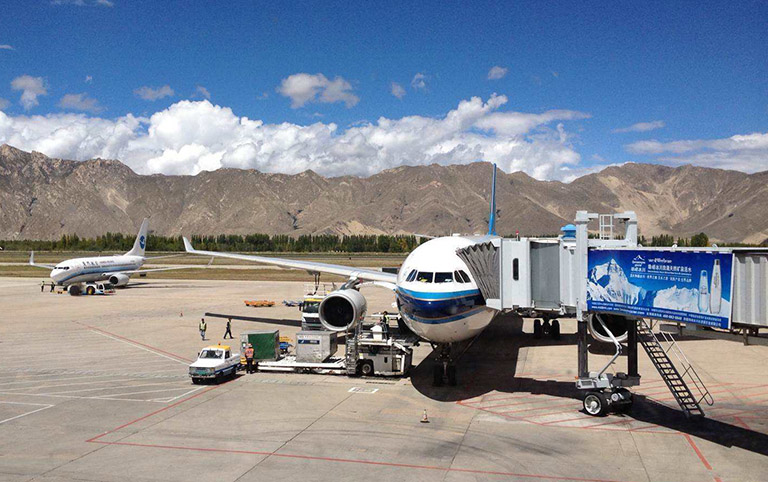 Lhasa Gonggar International Airport
Lhasa Gonggar International Airport
Day 2 Lhasa City Tour (B)
Today's highlights: Norbulingka Park, Drepung Monastery, Sera Monastery Buddhism DetabingToday you will visit popular attractions in Lhasa city and suburb to explore Tibetan culture. You will firstly go to visit the beautiful Norbulingka which used to be the former summer palace of Dalai Lamas in the ancient time, and now is a public park. Dotted with various kinds of precious flowers and plants, it is the genuine "Plateau Oxygen Bar". In addition to its magnificent buildings and colorful flowers, Norbulingka also features some big Tibet event activities during big festivals, like Tibetan shows in annual Shoton Festival. Next, drive several kilometers to the western outskirts of Lhasa to visit Drepung Monastery. Drepung, in Tibetan, means "prosperity". Since its establishment, Drepung Monastery has always been one of the most important Buddhist monasteries in Tibet. In its heyday, there were more than 10,000 monks lived and studied in the monastery. Throughout its history, many important and famous Tibetan leaders used to study here, especially the Dalai Lamas. So Drepung Monastery is also respectfully known as the "Mother School of Dalai Lamas". You can also enjoy a panoramic view of Lhasa from Drepung Monastery.
In the afternoon, you will be taken to another famous monastery in Lhasa - Sera Monastery. It is famous for the spectacular "Buddhism Debating". As a daily routine, the monks gather in a courtyard, and debate on the Buddhist doctrines with supplemented gestures, which is thought to be helpful to facilitates better comprehension of the Buddhist philosophy to attain higher levels of study. After enjoying the "Buddhism Debating", you will be transferred back to the city. The rest time is your own free time to rest.
The Etiquette of Visiting Monastery: 1) you shouldn't wear short and uncover shoulders; 2) taking off your sunglasses and hat before entering the chapels; 3) taking photos is usually not allowed inside the chapels.
-
 Our customers from Poland visited Sera Monastery
Our customers from Poland visited Sera Monastery
-
 Pay a visit to the Dalai's Summer Palace - Norbulingka
Pay a visit to the Dalai's Summer Palace - Norbulingka
Day 3 Lhasa Potala Palace Tour (B)
Today's highlights: Potala Palace, Jokhang Temple, Barkhor Street, Zongjiao Lukang ParkStart today's Lhasa exploration with an exciting visit to the landmark - Potala Palace which is the home to the successive Dalai Lama as well as a great masterpiece of Tibetan architecture. The whole palace is divided into the White Palace - living quarters and office to deal with political and Buddhist affairs for Dalai Lamas, and the Red Palace where houses several stupas of previous Dalai Lamas, many historical relics and precious arts. After entering the gate of Potala Palace, you need to walk up about 30 minutes along the zigzag stone paths with white-and-red walls to the White Palace. Remember to ascend the steps slowly and take some stops for sightseeing and rest which will be helpful to reduce high altitude sickness. Then explore the palace in an orderly way from the White Palace to the Red Palace, and exit from the back side. After Potala Palace visit, go to enjoy a leisure stroll in Zongjiao Lukang Park, a lovely park with pleasant scenery built around the lake behind Potala Palace. It is a great place to experience local Tibetans' living styles as you can see local people gathering and chatting, taking exercise, walking the kora, feeding wild birds and ducks, etc. If your day is clear, you can take some great photos of the reflection of Potala Palace on the lake in the park.
Continuing your exploration, you will then get to Jokhang Temple which is considered as the spiritual center of Lhasa and the most revered religious structure of Tibet. In front of Jokhang Temple, you can see crowds of pilgrims polishing the flagstones with their prostration, which is truly a heart-touching scene you will ever see. This temple is also known as the "house of Buddha" because it keeps the precious Jowo Rinpoche, the life-sized (5 foot/1.5m) image of the Shakyamuni at the age of 12. Rise to the top floor of this temple, you can see savor the beautiful golden roof and the view of Potala Palace afar. The last site for today’s exploration is the famous Barkhor Street. It is a circular and wide street encircling the Jokhang Temple. The local people like to walk on the street for several circles usually in the late afternoon as a daily tradition of pilgrimage. The street also has many shops selling a wide variety of traditional Tibetan goods, religious items and handcrafts.
Optional Activity: If your physical strength permits, take a short climb to the viewing-deck of Chakpori Hill to take a panoramic photo of Potala Palace after your Potala Palace visit.
Tips of today: 1) taking photos is not allowed inside the palace; 2) today you will be mainly outside, please bring some water, a hat, sun cream, and sun glasses with you.
-
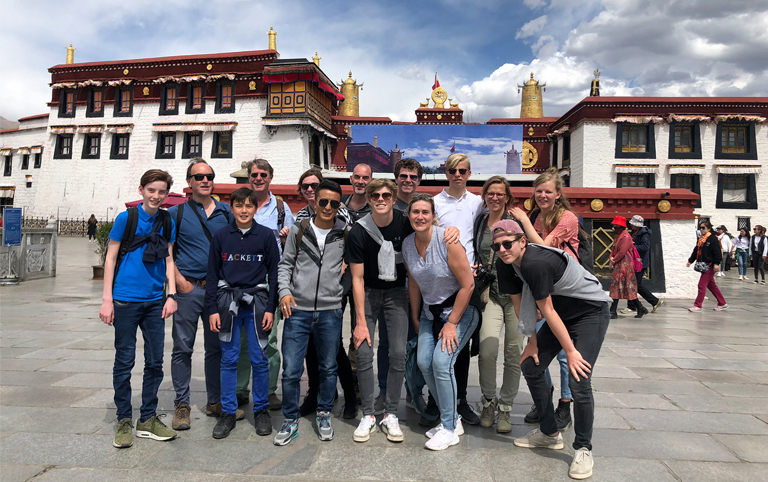 Our customers' Happy Time in Jokhang Temple
Our customers' Happy Time in Jokhang Temple
-
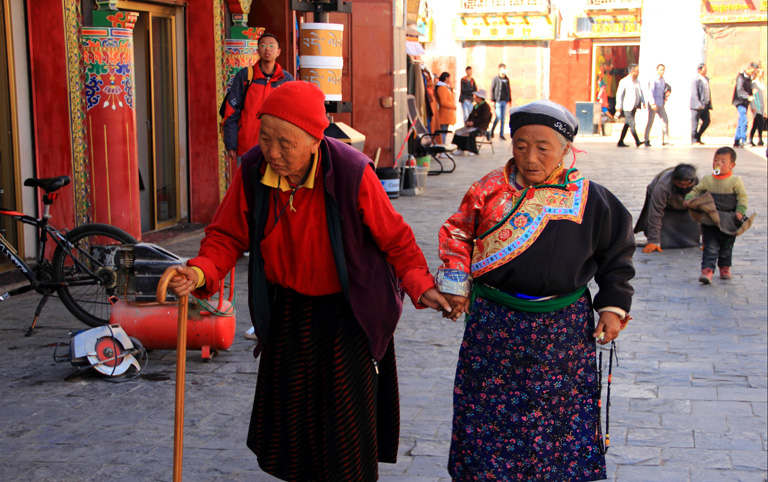 Old Tibetan Women on the Barkhor Street
Old Tibetan Women on the Barkhor Street
-
 Julie's family took photo with their guide in Potala Palace
Julie's family took photo with their guide in Potala Palace
Day 4 Lhasa - Namtso - Lhasa (B)
Today's Highlight: Namtso LakeToday, you will take an exciting trip to the holy lake Namtso – Tibet’s most beautiful lake and the world’s highest saltwater lake with an altitude of 4,818 meters. The overwhelming beauty also makes it known as the Heavenly Lake and the Paradise of Photographer. It needs 3.5 hours to drive to Namtso Lake but you will have a good view of Mt. Nyenchen Thangla Ranges on the way.
After your arrival, take a short rest and throw yourself into the incredible landscape of Namtso Lake. It’s quite common for tourists who are awestruck at the Namtso at the first sight. With the snowy mountains in the background, the crystal-clear dazzling blue water, Namtso is stretching to the horizon. In clear days, the lake looks like a beautiful turquoise surrounded by magnificent snow-capped Tanggula Mountains, and the lakeshore is green, wide and open, dotted with yaks and sheep of local nomads. For travelers, Namtso is the ideal place for photography and sightseeing. While for Tibetans, it is a sacred and magical lake for pilgrimage. You can see some Tibetans walk the kora around the lake with prayer wheels.
Lastly, drive back to Lhasa for accommodation.
Tips of Today: 1) the altitudes of Namtso Lake region is about 5, 000 meters, so you should be fully prepared for high altitude sickness. Do remember to keep warm all the time and avoid strenuous activity; 2) it is available ride a yak in Namtso lake but remember to ask for the owners’ permission and about the price in advance; 3) if you want to spend longer time and watch sunset, you can also accommodate at Damxung County for a night, which is about 1 hour's driving from Namtso Lake.
-
 Splendid Landscape of Namtso Lake
Splendid Landscape of Namtso Lake
-
 Jeff rode a Yake in Namtso Sceni Area
Jeff rode a Yake in Namtso Sceni Area
Day 5 Lhasa Departure (B)
Lhasa airport/train station drop offToday is free for you until your tour guide transfer you to the airport in time for your flight or drop you off at Lhasa train station.
Tips of today: 1) please pack your luggage carefully, especially for small things like camera charger, power adaptor, mobile phone, phone charger, wallet and towel; 2) if your flight is arranged in the afternoon, please make sure you check out the hotel before 12pm.
Price & Service Guide
The quotation for this trip is $839 per person
1. This price is based on a group of 2 adult travelers who will take our private tour and share one standard rooms in regular local 4-star hotel in lower seasons.
2. This price is subject to change according to your traveling season, group size, hotel class, change of activities in your itinerary and possible fluctuation of currency exchange rate. If you want a lower price, you can get more people to join you, or use economy class hotels.
3. This price is only valid to March 31, 2025.
4. Reference exchange rate of USD 1= RMB 6.85. The final quotation will be adjusted according to the latest real-time exchange rate.
What's included in this price?
- Private professional English-speaking local tour guide.
- A comfortable vehicle with a private driver.
- Airport (or train) pick up and drop off.
- Fee for Tibet Entry Permit application.
- All accommodations listed in the itinerary, based on double-occupancy. Comfortable class hotels in Lhasa.
- All meals as listed in the itinerary. (“B” for breakfast; “L” for lunch; “D” for dinner.)
- Admission fees and activity expenses, as noted in the itinerary.
- Service Charge (the planning, handling, operational and communication charges) & government taxes.
What's excluded in this price?
- China visa, all air tickets and train tickets to and from Tibet.
- Sightseeing not listed in the itinerary.
- Meals not listed in the itinerary.
- Personal expenses such as laundry, drink, fax, telephone call, optional tour activities, etc.
- Gratuities, tips to guides, drivers, bellboys, etc.
Value for money:
While the trip of a lifetime is priceless, we know value is a vital aspect for those deciding which tour to choose.
When comparing tour prices, be sure to compare like to like. Our tours are designed to ensure that our customers experience all the culture, history, and beauty that Tibet has to offer, and at a reasonable price.
A great way to enjoy the lowest possible price is to invite more people to join your trip to share the travel experience as well as the tour expense. The more people in a group, the lower the price per person. (We recommend you join our group tour if you are traveling alone. Please contact our travel consultant for more information)
Booking early is also an easy way to ensure the best rate! We highly recommend you contact us at least 1 month before your planned departure date.
Reviews of Our Customers
Still not know us well? Read what other travelers are sharing about their Tibet trip with Tibet Discovery (We only accept reviews from confirmed travelers who took our tours / activities, so you can surely rely on the reviews)
- Hi Rita
-
Excellent excellent tour. We really enjoyed all of our tour arrangements. Each tour guide was very flexible and allowed us to add tour sites and activities as we requested. This flexibility made the tour very very good. While it is nice to have an option for having lunch stops, we were not always hungry at lunch time and would have preferred to continue touring or just make a very brief stop to get a drink or snack rather than a full stop fot lunch.
Conrad

Conrad's family visited Potala Palce in April 2024, tour tailormade by Rita
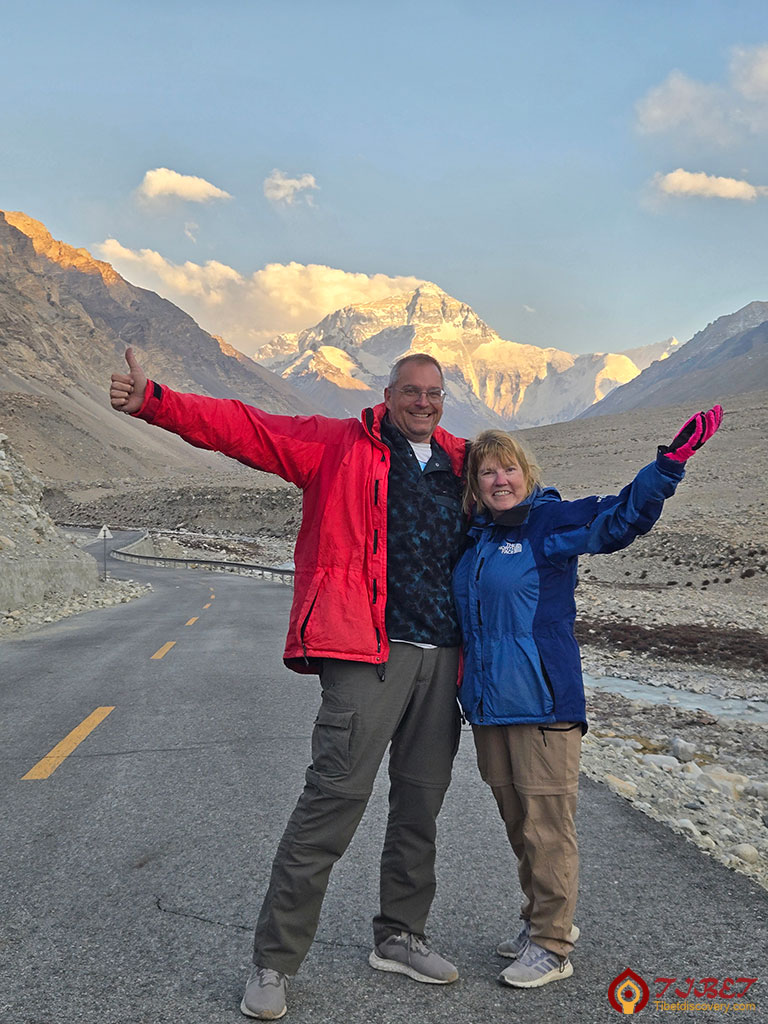
Conrad's family visited Mount Everest in April 2024, tour tailormade by Rita
- April 28, 2024
- Thank you Wonder,
-
A wonderful trip, giving me a great impression of Chengdu and Chongqing, thanks to the professional guide by Ellen and David.
Jesús
- February 18, 2024
- Thank you very much Mr Leo Li,
-
we were pleasantly satisfied with the service provided by you.
Pablo was very empathetic and adjusted to our needs, particularly in the speed at which we could walk. His Spanish very good. The van and driver also ok.
The sites visited were wounderful and the time spent in them was well balance.
EVERYTHING OK, thank you and greetings from Mexico.
Jesús
- December 20, 2023
Tour Photos Gallery
 Lhasa Gonggar International Airport
Lhasa Gonggar International Airport Our customers from Poland visited Sera Monastery
Our customers from Poland visited Sera Monastery Norbulingka Summer Palace
Norbulingka Summer Palace Our customers' Happy Time in Jokhang Temple
Our customers' Happy Time in Jokhang Temple Old Tibetan Women on the Barkhor Street
Old Tibetan Women on the Barkhor Street Julie's family took photo with their guide in Potala Palace
Julie's family took photo with their guide in Potala Palace Tibet Namtso Lake
Tibet Namtso Lake Jeff rode a Yake in Namtso Sceni Area
Jeff rode a Yake in Namtso Sceni Area
Recommended Add-on Options

-
Your Tibet Adventure is not complete without conquering the Mount Everest, the highest mountain in the world. Don't miss the chance to challenge yourself!
It needs only 4 days to take a Mount Everest Adventure from Lhasa. You will travel from Lhasa, via Gyantse and Shigatse, to the Everest Base Camp to explore the fascinating clear front face of the dominating Mount Everest. You will also stay a memorable night on the mountain, then drive back to Lhasa. The road to Mount Everest is another highlight with many unique sights to see, such as the holy lake Yamdrok, mysterious Palcho Monastery, Gelug tradition of Tashilhunpo Monastery, etc.

-
Tibet Golden Triangle - extending your Tibet tour from Lhasa to Gyantse and Shigatse to experience authentic Tibetan culture and history!
Diverse and unique sights, great road condition, enjoyable accommodation and dinning - that's why you should extend your Tibet trip to Gyantse and Shigatse. You will not only enjoy magnificent high plateau landscape along the road, but also explore many famous and unique attractions in Tibet, including the tranquil heavenly lake Yamdrok, imposing Karola Glacier, Palcho Monastery, Tashilhunpo Monastery. Only 2 days are needed to experience these all!
Useful Trip Notes
- 1. Tibet Permits Guaranteed
To travel in Tibet, all Non-Chinese passport holders need to have a Tibet Travel Permit which is issued by Tibet Tourism Bureau in Lhasa. And only Chinese travel agencies like Tibet Discovery can apply for the permit on behalf of tourists. You must obtain it before your tour starting because the permit will be checked when you board your flight/train to Tibet. Traveling with Tibet Discovery, you don't have to worry about the complicated procedures of Tibet Travel Permit application. All you have to do is to confirm a tour package with us and send us your passport and Chinese visa copies at least 15~20 days in advance before your tour, then we will take care of all the rest things. Once the permit is issued, we will deliver to your address in China, such as your hotel, local travel agency, etc. - 2. Available Months to Visit Tibet
Generally speaking, April to October is the best time. July and August are the peak season and rainy season. It is usually snowy and cold in winter, which is not suitable for visit Mount Everest, Namtso and Mount Kailash regions. While other places such as Lhasa, Gyantse and Shigatse are suitable for travel all year around. The temperatures in daytime and night differs a lot, usually 5~15℃ in the daytime and -5~0℃ in the night, so please wear accordingly. - 3. High Altitude Sickness
The average altitude of Tibet is about 4000 meters above the sea level (Lhasa: 3700m; EBC: 5200m; Namtso: 4718m). You may suffer a bit from High Altitude Sickness in the beginning days of your Tibet trip if you haven’t had rich high plateau travel experience. But don’t worry too much, the high altitude can be acclimatized usually in 2~3 days. Our suggestion is to take a physical examination and get suggestions from your doctor, and also bring some medicines to prevent from High Altitude Sickness before your trip. While in Tibet, you should keep warm all the time, avoid strenuous activities, drink more water and eat more vegetables and carbohydrates. You’d better not take showers during the first two days after your arrival in Tibet. If you don’t feel well, get help from your tour guide or go to the hospital without any delay. - 4. How to Go to Tibet
Basically you have two options – flight and train. Currently, you can take a flight to Lhasa from Beijing(4.5hrs), Xian(3.7hrs), Chengdu(2.5hrs), Chongqing(3hrs), Kunming(3hrs), Kathmandu (1.5hrs), etc. Among all these cities, Chengdu and Xian have more frequent flights to Lhasa.
If you prefer a train travel, you can take a train to Tibet from Beijing(40.5hrs), Xian(32hrs), Chengdu(43hrs), Shanghai(47hrs), Chongqing(42hrs), Lanzhou(25hrs), Xining(22hrs), Guangzhou(54hrs). - 5. Packing and Wearing Ideas
Firstly you can’t forget your passport and Chinese Visa. A large backpack and a smaller one are recommended (the smaller one can be used for daily activities). Also bring necessary medicine you need. Other stuffs like sunglasses, snow glasses, hats, lip balm, sun block are recommended.
As for wearing, you are suggested to dress in layers (both thin and thick jackets). Down jacket is necessary in Spring and Autumn. A pair of durable and comfortable shoes is necessary.
Other Recommended Tour Packages
Tibet has too much to offer and our aim is to bring you the best experience in Tibet. Following are some other recommended Tibet tour packages that you may be interested in. All of our Tibet tour packages are customizable to meet your personal requirements. You can also contact us to customize a trip if you want.
-

Lhasa / Gyantse / Shigatse / Everest / Lhasa
8 Days Lhasa to Mount Everest Private Tour
Potala Palace, Yamdrok Lake, Tashilhunpo Monastery, Mt. Everest
$1,599 / Details -

Lhasa / Gyantse / Shigatse / Lhasa
6 Days Lhasa Gyantse Shigatse Private Tour
Potala Palace, Yamdrok Lake, Tashilhunpo Monastery...
$1,049 / Details -
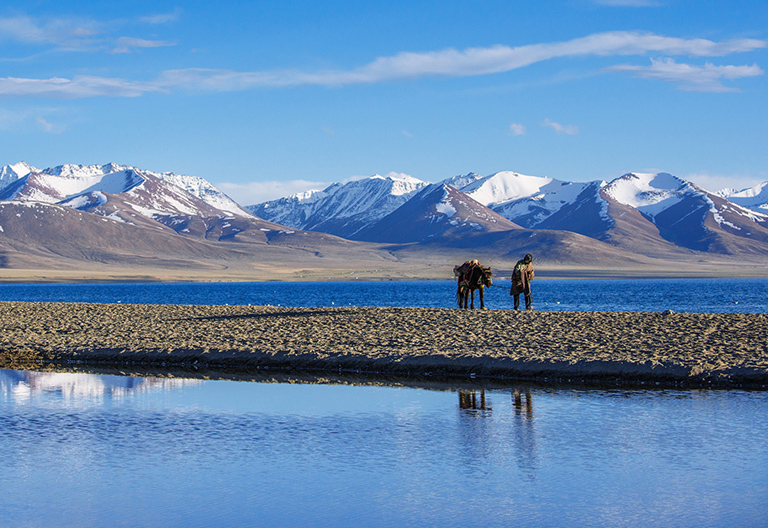
Lhasa / Namtso / Lhasa
6 Days Holy Lake Namtso In-depth Private Tour
Potala Palace, Barkhor Street, Sera Monastery, Namtso Lake
$939 / Details



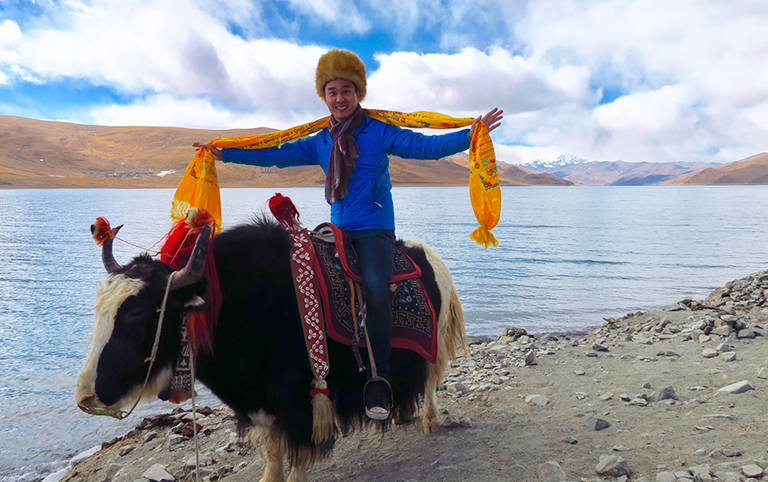

 Karen
Karen Wonder
Wonder Jack
Jack Rita
Rita Johnson
Johnson Vivien
Vivien Wing
Wing Ariel
Ariel Leo
Leo Tracy
Tracy Evelyn
Evelyn April
April Phoebe
Phoebe Kelly
Kelly Felix
Felix Sean
Sean